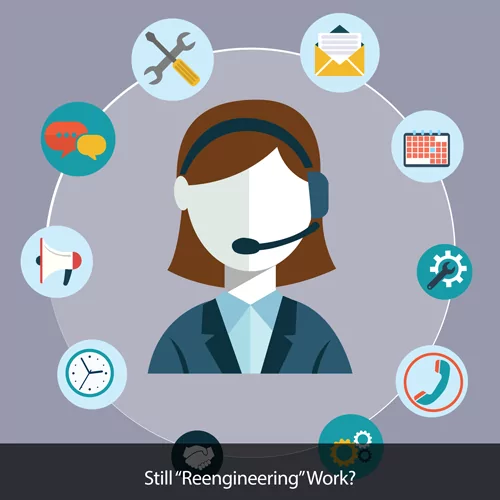Are We Still “Re-engineering” Work?

In 1990, Michael Hammer published an article in the Harvard Business Review calling upon US businesses to “re-engineer” the workplace. His argument was straightforward. In a nutshell, he argued that US business processes had become “outmoded and obsolete.” More specifically, he argued “Many of our job designs, work flows, control mechanisms, and organizational structures came of age in a different competitive environment and before the advent of the computer. They are geared towards efficiency and control. Yet the watchwords of the new decade are innovation and speed, service and quality.” Hammer further argued that in order to truly modernize, organizations would need to do more than install computers on workers’ desks—they would need to reengineer their managerial structures from top to bottom.  In many respects, Hammer’s argument served as a wake up call to US businesses—many of which were, at the time, struggling to keep up with more streamlined and efficient Japanese organizations. But twenty-five years later, are we still struggling with the same problems? Did this radical restructuring of work actually happen? To answer these questions, it’s useful to consider Hammer’s recommendations point-by-point.
In many respects, Hammer’s argument served as a wake up call to US businesses—many of which were, at the time, struggling to keep up with more streamlined and efficient Japanese organizations. But twenty-five years later, are we still struggling with the same problems? Did this radical restructuring of work actually happen? To answer these questions, it’s useful to consider Hammer’s recommendations point-by-point.
Principles of Reengineering—Revisited
Organize around outcomes, not tasks.
In principle, this means replacing the assembly line model with a model where one point person (e.g., a customer service representative) follows a process through to the end. Ideally this means that outcomes can be achieved with fewer workers and that less information is lost as a task is completed. Has this happened? While project-based assignments are more common in today’s economy (e.g., in the IT sector), tasks have by no means disappeared. Indeed, new peer-to-peer platforms, like Mechanical Turk, take large jobs and break them down into small tasks that can be completed in a minute or two. So while outcomes have become more important in some organizations, peer-to-peer platforms have resulted in a new task-based approach to work.
Have those who use the output of the process, perform the process.
It was once assumed that users needed technicians. In the heyday of Xerox, for example, meticulously trained Xerox technicians were regular visitors in most offices. Today, office copiers tell us how to handle most basic repairs (e.g., by offering a map and flashing light to indicate where paper jams are located or by telling us when and how to replace the copier’s drum). Most computers are also designed to walk us through basic repairs. In other words, in the twenty-first century, a receptionist, who would have once spent part of his or her day scheduling copy machine and computer repairs, is now also a technician. By and large, whether or not businesses have made a concerted effort to reengineer, this objective has been realized.
Subsume information processing work into the real work that produces the information.
In the past, information was processed by separate people or departments. Today, information processing is integrated at the source. Indeed, the development of ERP (Enterprise Resource Planning) software continues to achieve levels of integration that Hammer likely could not have even predicted in 1990.
Link parallel activities rather instead of integrating their results.
In the past, development of new products was often carried out in isolation. For example, electrical engineers and marketing staff may never have a face-to-face conservation. Today, parallel activities are increasingly integrated as project teams come together to achieve specific outcomes . That said, however, as many organizations outsource specific tasks and more workers (full-time and part-time) work remotely, we also face new challenges on the integration front.
Put the decision point where the work is performed, and build control into the process.
In the past, there was a tacit assumption that people who do the work are separate from those who monitor the work and make decisions about the work. According to Hammer, reengineering the workplace means compressing these processes. Has this happened? On the one hand, new technologies have empowered workers by giving them access to more layers of information and by expanding their jobs, but are we less management heavy than we were in 1990? While managers may spend less time supervising employees, management has arguably grown rather than dwindled in many organizations with many new types of managers appearing on the scene (e.g., change managers).
Capture information once and at the source.
Hammer’s final and most simple point is that in a digital age, there is no need to gather information more than once. Once one has taken an order, for example, all the information about the customer and product is in a system and visible to anyone else who will have contact with the customer or order. This, perhaps more than any other principles of reengineering, is one that has been achieved in most organizations.
So would Hammer approve? By and large, the reengineering he called for in 1990 has been carried out but with a few notable exceptions. First, the shift from outcomes to tasks may in the end be threatened by digital platforms that enable work to be broken down into ever-smaller tasks. Second, while development work may be more likely to happen on a parallel basis, the rise of the virtual work team and workplace also poses new challenges. In essence, the technologies that made reengineering necessary and possible have also given rise to new challenges that require new technological solutions, and this is something Hammer did not fully anticipate.